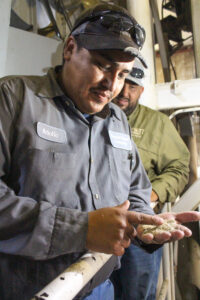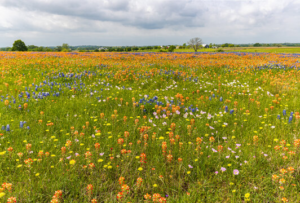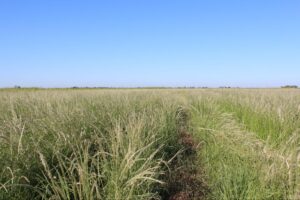Reclaiming land after oil and gas operations requires strategies that go beyond temporary fixes. Using native prairie grasses can revitalize soil health, control erosion, and offer sustainable growth.
For project managers in southern oil and gas sectors, choosing native grasses tailored to your reclamation needs can be pivotal.
Why Native Prairie Grasses for Reclamation?

Native prairie grasses, like Sideoats Grama and Buffalograss, are not just visually appealing—they’re built for Texas-area climates. These resilient species support land restoration by improving soil structure and fostering habitats for native wildlife.
Benefits of Native Prairie Grasses for Reclamation Projects
Soil Health and Stability
Prairie grasses contribute organic matter, which enriches the soil over time. Roots of native species extend deep underground, helping maintain soil structure and reduce compaction. This process ensures long-term site stability, essential for oil, gas, and solar reclamation.
Example: Little Bluestem is a Texas favorite for its extensive root system that thrives in dry conditions and aids in reducing soil erosion.
Erosion Control
Erosion poses a significant risk on disturbed sites, where wind and water can remove loose topsoil. Native grasses such as Indiangrass and Switchgrass form dense root networks, holding the soil in place. They are excellent options for sloped areas where erosion is a primary concern.
Cost Efficiency and Sustainability
Once established, native grasses require minimal maintenance, saving time and resources. Their natural adaptation to local conditions means reduced water needs and lower overall costs. Compared to non-native options, native grasses can better withstand Texas’s periodic droughts and fluctuating temperatures.
Selecting the Right Native Prairie Grasses for Your Project
Choosing the correct grass mix depends on your site’s specific conditions, goals, and timing. Bamert Seed Company offers custom blends suited to varying regions, from the dry plains to wetter areas near the coast.
Common Native Grasses for Texas Reclamation Projects

Buffalograss (Bouteloua dactyloides)
Ideal for low-maintenance sites with full sun exposure. Buffalograss thrives in well-drained soils and requires minimal watering once established.
Buffalograss has a low-growth habit, which helps reduce the need for mowing and limits competition with other vegetation. Additionally, its deep-rooted structure aids in soil stabilization, preventing erosion on flat or gently sloping land.
This grass is particularly well-adapted to the conditions of the Texas Panhandle and West Texas, where it can withstand intense summer heat with little water.

Sideoats Grama (Bouteloua curtipendula)
Great for diverse soil types including sandy, loamy, and even rocky soils. Known for drought resistance, it provides valuable habitat for wildlife.
Known for its characteristic drooping seed spikes that hang along one side of the stem, Sideoats Grama is both drought-resistant and provides critical habitat for wildlife. Its foliage and seed heads attract various pollinators and serve as forage for native fauna.
In Texas reclamation projects, this grass’s resilience to dry conditions and varying soil textures allows it to stabilize disturbed soils while promoting local biodiversity. It’s particularly effective on slopes and sites with moderate erosion risks.

Indiangrass (Sorghastrum nutans)
Beneficial for sites needing erosion control. With its tall growth, it acts as a natural windbreak and stabilizes soil on steep areas.
It’s especially beneficial on steep or erosion-prone sites, where its tall growth can serve as a natural windbreak, reducing soil loss from wind erosion. This grass is well-suited to areas with partial to full sun and moderate soil moisture levels, and it performs well in clay and loam soils commonly found throughout Central and East Texas.
Indiangrass also supports wildlife by providing nesting cover for birds and food for pollinators, making it a valuable choice for ecological restoration in addition to erosion management.
Using Seed-Spec for Customized Reclamation Planning
Currently available for Texas and surrounding areas, Seed-Spec is a powerful tool for precise reclamation planning. Choose your project location and create native seed mixes based on specific project needs like soil type, climate, and erosion risks, making it ideal for large-scale sites.
Working with Bamert Seed Company
We recommend discussing your specific project requirements with our specialists. For example, if your project has a high risk of erosion, a custom blend emphasizing Switchgrass and Sideoats Grama might be ideal.
With Seed-Spec’s tailored recommendations and Bamert’s local expertise, you can develop an efficient, high-success reclamation plan that aligns perfectly with your site’s unique conditions.
4 Successful Reclamation Tips for Native Prairie Grasses
Restoring oil and gas sites requires specific strategies to address challenges like soil degradation and erosion. Here are four targeted tips to ensure successful reclamation with native prairie grasses, tailored for the unique needs of these sites:
1. Assess Site Conditions
Soil type, slope, and climate conditions should guide grass selection.
Examples: In Texas, soil conditions vary significantly from sandy soils in West Texas to clay-rich soils in the East.
For a project in the sandy soils common in the Permian Basin, native species like Buffalograss and Little Bluestem are well-suited for their drought tolerance and adaptability to loose soils.
For clay-heavy soils, Eastern Gamagrass can handle more compact, moisture-retentive conditions.
Bamert’s team can help you evaluate which species will thrive on your site.
2. Timing and Maintenance

Fall plantings can be successful under the right conditions, but they come with unique challenges.
Timely rains are crucial; without them, supplemental irrigation may be necessary to support germination and early growth. Additionally, fall seedlings need adequate time to develop a strong, diverse root structure to survive winter conditions. An early freeze can jeopardize their survival, making fall plantings a delicate balance between timing and environmental factors.
For most projects, especially those reliant on rainfall, spring seedings are often the safer and more effective choice. The consistent moisture of spring and milder temperatures create favorable conditions for germination and establishment, setting the stage for long-term success.
For instance, planting Switchgrass or Sideoats Grama in early spring or fall gives these grasses the best chance to develop deep roots that will help with drought tolerance.
Maintenance during early establishment, such as controlled watering or early weed control, is crucial to give these native grasses a solid start.
3. Incorporate a Mix of Species
A diverse grass mix promotes a balanced ecosystem, supporting various wildlife and enhancing soil resilience.
Examples: A blend of species like Indiangrass, Big Bluestem, and Sideoats Grama offers benefits beyond resilience.
While Indiangrass provides excellent soil stabilization with its tall growth, Big Bluestem can create valuable wildlife habitats, and Sideoats Grama supports pollinators.
Incorporating various species helps restore ecological balance, supports local biodiversity, and creates a more resilient ecosystem capable of handling environmental stressors such as drought or heavy rains.
4. Use Erosion Control Techniques

Temporary barriers or blankets can prevent soil loss while grasses establish, especially in areas prone to heavy rain.
Example: On sites with a high risk of erosion, temporary erosion control methods such as straw blankets or coir mats can stabilize the soil while native grasses like Green Sprangletop and Blue Grama become established. These methods are particularly useful in regions with slopes or areas that receive periodic heavy rains.
On larger sites, planting a quick-growing cover crop alongside slower-growing native species can also provide interim erosion control while the native grasses mature.
Erosion isn’t just about soil loss, proper erosion control protects water quality.
Partnering with Bamert for Your Reclamation Needs
At Bamert Seed Company, we’ve helped numerous Texas project managers restore oil and gas sites by selecting and cultivating the right native seed mixes. By planting native prairie grasses, you’re investing in a sustainable future for your land.
Reach out to a Bamert specialist to explore our seed blends and receive custom recommendations tailored to your site’s needs. We’re here to help make your reclamation project successful — from the ground up.



